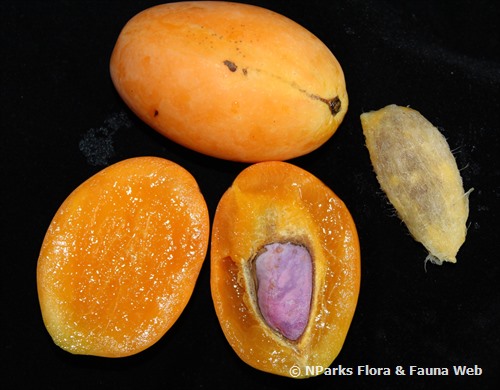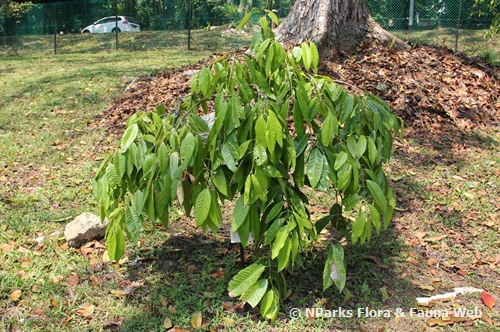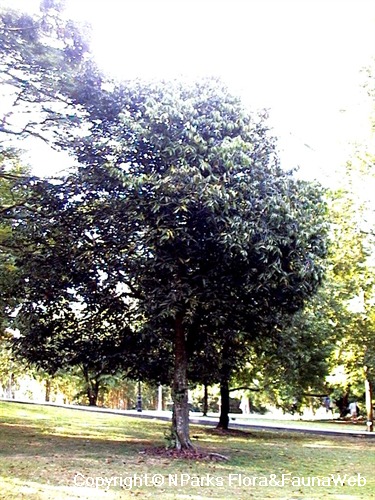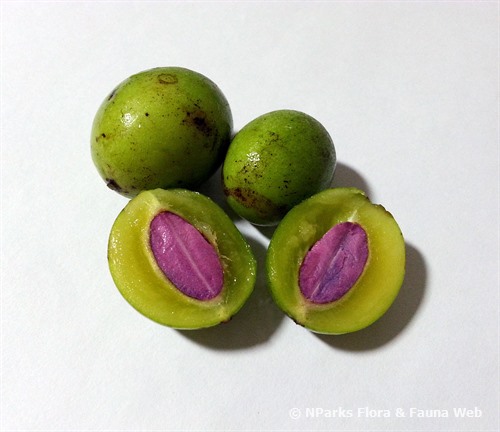
Back
Bouea macrophylla Griff.
| Family Name: | Anacardiaceae |
| Synonyms: | Bouea gandaria Blume, Tropidopetalum javanicum Turcz. |
| Common Name: | Kundangan, Kundang, Gandaria, Setar, Gandariah, Gondongan, Kondongan, Rembunia, Remenia, Rumia |
Bouea macrophylla or Kundangan is an evergreen tree of up to 27 m tall. It has a conical to round crown, small light yellowish-green to yellow coloured flowers. Kundangan produce dark grey gummy drops when the bark is cut. This native tree bear yellow to orange fruit which carries a faint turpentine smell, often cooked in syrups or used in Sambal.
Name
Classifications and Characteristics
| Plant Division | Angiosperms (Flowering Seed Plants) (Dicotyledon) |
|---|---|
| Plant Growth Form | Tree (Medium (16m-30m)) |
| Lifespan (in Singapore) | Perennial |
| Mode of Nutrition | Autotrophic |
| Plant Shape | Rounded, Conical |
| Maximum Height | 27 m |
Biogeography
| Native Distribution | Thailand, Peninsular Malaysia, Singapore, Sumatra, West Java and Borneo. |
|---|---|
| Native Habitat | Terrestrial (Primary Rainforest, Secondary Rainforest) |
| Preferred Climate Zone | Tropical |
| Local Conservation Status | Native to Singapore (Critically Endangered (CR)) |
Description and Ethnobotany
| Growth Form | It is an evergreen tree up to 27 m tall, with a dense, bushy, conical or round crown. Dark grey, gummy drops are produced when the bark is cut. |
|---|---|
| Crown | Dense, bushy, conical or round crown. |
| Trunk | Light brown fissured bark and often with pendulous, hairless, angular or flattend branchlets. |
| Foliage | Its opposite, stalked leaves have leathery leaf blades that are egg-shaped-oblong to lance-shaped, 10–30 by 4–8 cm, and tapering to blunt tips. |
| Flowers | Its branched flowering shoots are 4.5–13 cm long, and found often on the twigs behind the leaves. They bear very small flowers that are light yellowish-green or light yellow, soon becoming brown. |
| Fruit | Its fleshy fruits are almost round, yellow or orange when ripe, and 3.5–5 by 3–4 cm. The fruits taste sweet to sour and has a faint turpentine smell. |
| Habitat | It grows in lowland forests up to 300 m altitude. It occurs locally in Bukit Timah Nature Reserve, and Pulau Tekong. |
| Associated Fauna | Its flowers are insected pollinated. The ripe fruits are eaten by frugivorous birds and mammals. The leaves are also the food plants for the moth species Archips mimicus, Gymnoscelis imparatalis, Penicillaria jocosatrix and Syllepte cohaesalis. |
| Cultivation | Bouea macrophylla is usually propagated from seed but also easily propagated through marcotting and grafting. |
| Ethnobotanical Uses | Edible Plant Parts : Edible Fruits, Edible Leaves, Edible Seeds Food (Fruit or Vegetable): Although even when fully ripe, the fruit is still generally rather sour and consumed fresh, cooked in syrup or made into excellent compote. Look for fruit that has a deep shade of yellow or orange. The young fruits are used in the making of ‘sambal’ as the bright purple cotyledons in the big seed adding to the attraction of concoction. The edible fruits are made into jam. The young leaves are also consumed fresh together with the ‘sambal’. (Herb or Spice) Timber & Products: The timber is used for constructional work, and to make scabbards for the kris. Others: As it has very dense foliage, it is suitable to be an excellent shade tree. |
Landscaping Features
| Landscaping | It may be suitable for parks and gardens. |
|---|---|
| Landscape Uses | General, Parks & Gardens, Small Gardens, Shade Providing Tree / Palm |
| Thematic Landscaping | Economic Garden |
Fauna, Pollination and Dispersal
| Fauna Pollination Dispersal Associated Fauna | Caterpillar Moth Food Plant (Leaves) |
|---|---|
| Pollination Method(s) | Biotic (Fauna) |
| Seed or Spore Dispersal | Biotic (Fauna) |
Plant Care and Propagation
| Light Preference | Full Sun, Semi-Shade |
|---|---|
| Water Preference | Moderate Water |
| Plant Growth Rate | Moderate |
| Rootzone Tolerance | Moist Soils, Well-Drained Soils |
| Propagation Method | Seed, Grafting, Marcotting, Air-Layering |
Foliar
| Foliage Retention | Evergreen |
|---|---|
| Mature Foliage Colour(s) | Green, Purple |
| Mature Foliage Texture(s) | Leathery |
| Prominent Young Flush Colour(s) | Cream / Off-White, Purple |
| Foliar Type | Simple / Unifoliate |
| Foliar Arrangement Along Stem | Opposite |
| Foliar Attachment to Stem | Petiolate |
| Foliar Shape(s) | Non-Palm Foliage (Lanceolate, Elliptical) |
| Foliar Venation | Pinnate / Net |
| Foliar Margin | Entire |
| Foliar Apex - Tip | Acute, Obtuse |
| Foliar Base | Acute, Cuneate |
| Leaf Area Index (LAI) for Green Plot Ratio | 3.0 (Tree - Intermediate Canopy) |
| Prominent Young Flush Colour(s) Remarks | Young leaves are usually deep violet, but sometimes strikingly white when they emerge. |
Non - Foliar and Storage
| Trunk Type (Non Palm) | Woody |
|---|---|
| Bark Colour(s) | Light grey. Dark grey, gummy drops are produced when the bark is cut. |
| Mature Bark Texture | Fissured |
| Root Type | Underground |
Floral (Angiosperm)
| Flower & Plant Sexuality | Bisexual Flowers , Bisexual Flowers |
| Flower Colour(s) | Brown, Green, Green - Light Green, Yellow / Golden |
|---|
| Flower Grouping | Cluster / Inflorescence |
| Flower Location | Axillary |
| Flower Symmetry | Radial |
| Individual Flower Shape | Bowl-shaped |
| Inflorescence Type | Panicle |
| Flowering Habit | Polycarpic |
Fruit, Seed and Spore
| Mature Fruit Colour(s) | Orange, Yellow / Golden |
|---|---|
| Fruit Classification | Simple Fruit |
| Fruit Type | Fleshy Fruit , Non-Accessory Fruit |
References
| References | Chayamarit, K (2010). Anacardiaceae. Flora of Thailand, 10(3), pp. 265 - 268. Bangkok: Forest Herbarium, Royal Forest Department. |
|---|
Image Repository
Others
| Master ID | 1460 |
|---|---|
| Species ID | 2753 |
| Flora Disclaimer | The information in this website has been compiled from reliable sources, such as reference works on medicinal plants. It is not a substitute for medical advice or treatment and NParks does not purport to provide any medical advice. Readers should always consult his/her physician before using or consuming a plant for medicinal purposes. |




